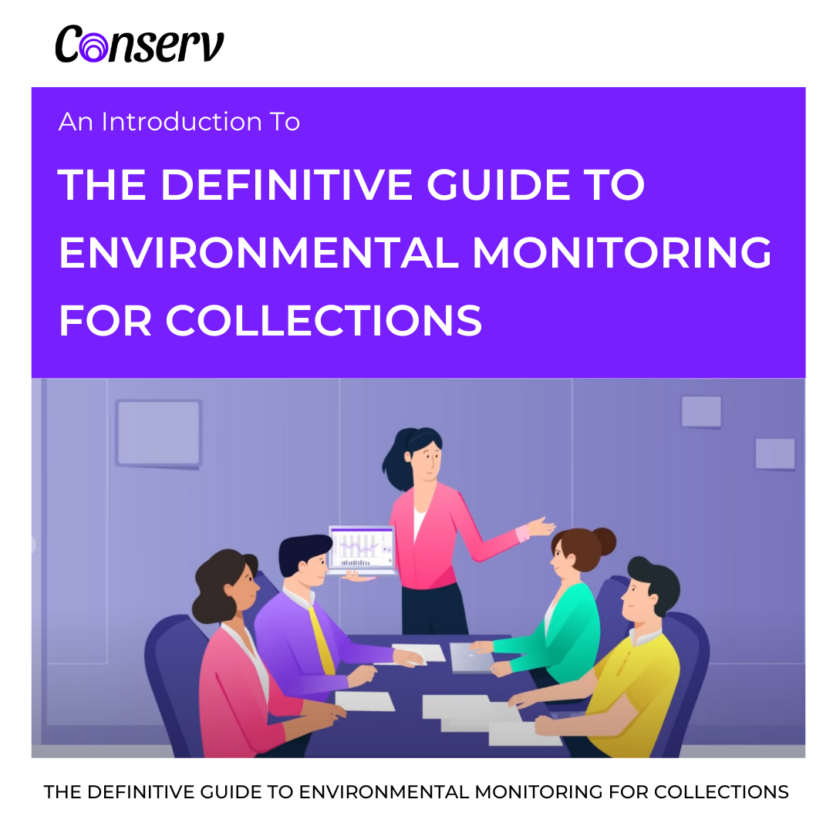The Definitive Guide to Environmental Monitoring for Collections?!
We’ve long had the idea for a definitive guide to environmental monitoring for collections – the topic of this post. The idea of a definitive guide is a bit tongue in cheek.
When we started Conserv in the fall of 2018, Nathan and I were convinced that preservation professionals around the world would benefit from better environmental monitoring tools. Looking back I think we underestimated the level of enthusiasm from the cultural heritage community. People were very interested in a new kind of company, completely focused on environmental monitoring for collections.
Like a lot of the work we’ve done over the last four years, this idea for a definitive guide might come across as immodest. Who are we to lay claim to a definitive guide to this subject area?
The preservation field is characterized by a desire to continuously learn and improve on the methods of the previous generation. This “definitive” guide is merely the latest attempt to bring together what’s known about this subject in one place. We fully expect this content to need frequent updating as the field evolves.
Definitive here doesn’t mean final, but does mean authoritative. And definitive doesn’t mean complex and academic – we plan to cover the practical knowledge a professional should have to run a quality monitoring program.
Conserv is in A Unique Position to Put this Information Together
Well, we’re Conserv and we believe that environmental monitoring tools should support the way collections work. While there are many good general purpose data loggers on the market today, none support the unique preservation needs of collections. We believe that solving this problem is critical for this generation and the ones that follow.
The biggest change over these last four years is that Conserv isn’t an outsider anymore. We’ve spoken with thousands of preservation professionals about monitoring since we started and we’ve partnered with over 300 collections in the US, Canada, and Europe to provide high quality monitoring services.
The guide is going to come together across 15 blog posts that we’ll publish over the next 5 months on our website – some written by us, many written by knowledgeable experts around the field.
We believe that environmental monitoring tools should support the way collections work. While there are many good general purpose data loggers on the market today, none support the unique preservation needs of collections. We believe that solving this problem is critical for this generation and the ones that follow. – Austin Senseman, CEO
In this post I hope to give you a sense of what we believe in as a company and how we’ll approach the topic.
Environmental Monitoring Isn’t About Just Temperature and Relative Humidity
At Conserv when we talk about collection environments we mean all of the agents of deterioration that challenge the health of your collection objects. To this day, the Canadian Conservation Institute still has the best documentation of the ten agents of deterioration. In this guide we’ll connect the dots between some of these 10 areas and the day-to-day work on creating a great collection environment.
At Conserv we believe that great environmental monitoring happens when well-trained people have great technology. Talented preservation professionals are primary, and great sensors and software are there to support their work. This guide is meant to be a resource for preservation professionals to identify areas of practical improvement for their collection.
Environmental Monitoring Should Be Accessible to Everyone
And finally, at Conserv we believe that environmental monitoring isn’t just for conservators. Most people engaged in the care of collections have other titles, other backgrounds, other training. For us to address the magnitude of the environmental monitoring challenge we have to empower collections staff from all backgrounds to interpret and act on preservation data. In this guide we attempt to make a complex subject approachable for people from diverse backgrounds.
A Quality Collection Environment is the Foundation of Good Collections Care
If your collection environment is the foundation of good collection care, then you can’t afford to not monitor what’s happening. Sadly our survey data shows that most collections aren’t adequately monitoring their collection environment. Money is part of the problem but so is people’s time and their knowledge.
Throughout this guide we’ll make the case for how collections of all sizes and geographies and budgets can take practical steps today to improve their environments. At Conserv we believe that perfection is the enemy and that it’s within everyone’s power to make progress. This is why we offer free software, our preventive conservation community, educational webinars, and guides like this one.
We’re Working In a Spirit of Transparency, Accessibility, and Inclusivity
It’s in this spirit that we’re putting together the Definitive Guide to Environmental Monitoring for Collections. This is going to be a lot of fun and we’re excited to assemble the most up-do-date information on this important topic.





